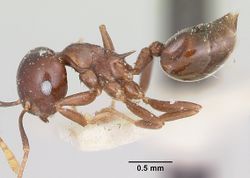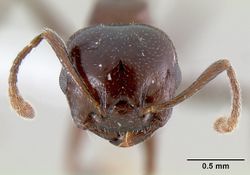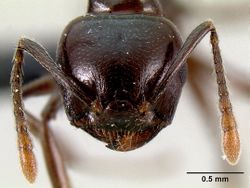Key to Crematogaster hova-group workers of Madagascar
This worker key is based on: Bonnie B. Blaimer 2010. Taxonomy and Natural History of the Crematogaster (Decacrema)-group (Hymenoptera: Formicidae) in Madagascar. Zootaxa. 2714:1–39.
This key does not include Crematogaster liengmei.
You may also be interested in
1
- Petiole dorsally with postero-lateral tubercles, each bearing a single, stiff and long erect seta (Fig. 21a); postpetiole distinctly bilobed and broadly medially impressed, with a pair of dorso-posterior stiff, long erect setae (Fig. 21b); abdominal tergites 4–7 usually with scattered erect pilosity; mandibles with 4 teeth . . . . . 2
- Petiole dorsally lacking postero-lateral tubercle, setae commonly absent, if present (rare) then short and feeble; postpetiole variable, usually without erect setae; erect pilosity absent from abdominal tergites 4–7; mandibles with 4–5 teeth . . . . . 3
2
- Lateral portions of promesonotum raised with respect to median portion, and with postero-lateral carinate denticles and lateral carinae bordering metanotal groove, in lateral view promesonotum appearing dorsally flat (Fig. 22); widespread in western and southern dry and spiny forests . . . . . Crematogaster grevei
- Lateral portions of promesonotum not raised with respect to median portion, postero-laterally rounded or angular and metanotal groove without lateral carinae, in lateral view promesonotum forming a more or less convex outline (Fig. 23); rare, montane forests of southern central Madagascar . . . . . Crematogaster malala
3
- Head and promesonotal sculpture well pronounced, deeply costulate or areolate . . . . . Crematogaster hova-complex
- Head and promesonotal sculpture less developed, from reduced-aciculate to reticulate, reticulate-areolate to weakly costulate . . . . . 4
4
- Face lacking erect setae except a single pair near frontal carinae; subpetiolar process developed as broad protuberance (Fig. 25 and 38b); small to medium size (HW 0.86-1.04, WL 0.80-1.05); propodeal spines small to medium size (SPI 0.15–0.20); sculpture on head and promesonotum always reduced-aciculate; northern, northwestern Madagascar and Ambohitantely forest . . . . . Crematogaster nosibeensis
- Face with additional erect setae (careful, could be abraded) other than those close to frontal carinae; subpetiolar process variable; size highly variable, small to very large (HW 0.74–1.31, WL 0.78–1.34); propodeal spines variable (SPI 0.17–0.40), but commonly SPI > 0.20; sculpture variable . . . . . 5
5
- Subpetiolar process developed as acute, long tooth (Fig. 24 and 39b); promesonotal suture usually complete; medium to large size (HW 0.89–1.14, WL 0.91–1.12); propodeal spines small to medium size (SPI 0.17–0.21); head and promesonotal sculpture always reduced-aciculate; rare, known only from montane forests in R. S. Manongarivo . . . . . Crematogaster sisa
- Subpetiolar process variable, moderately articulated as angular dent (Fig. 26, 49b, 50b, 52b and 53b), close to absent (Fig. 27 and 51b), or rarely as a broad protuberance (Fig. 40b); promesonotal suture often incomplete, if complete, then large to very large species (HW 1.09–1.21, WL 1.18–1.32); otherwise size highly variable; propodeal spines usually with SPI > 0.20; sculpture variable . . . . . 6
6
- Mesonotum postero-laterally distinctly angular to tuberculate (Fig. 28b and 30b); large to very large species (HW 1.09–1.31, WL 1.18–1.34); head usually reduced-aciculate, sometimes reticulate to feebly costulate; uncommon, central, eastern central and southeastern Madagascar . . . . . 7
- Mesonotum postero-laterally rounded or slightly tuberculate (Fig. 29), rarely angular; body size small to large (HW 0.74–1.19, WL 0.78–1.22); head sculpture variable, aciculate, reticulate or reticulate-areolate, if head sculpture reduced and aciculate, then usually at least promesonotal sculpture more developed; widespread throughout humid forests in Madagascar . . . . . Crematogaster hova-complex
7
- Mesonotum raised with respect to pronotum and medially at least slightly tuberculate (Fig. 30a); promesonotal suture usually complete (Fig. 31a); head and promesonotal sculpture always aciculate . . . . . Crematogaster mahery
- Mesonotum usually not raised with respect to pronotum nor medially tuberculate (Fig. 28a), promesonotal suture usually incomplete (Fig. 31b) and only laterally impressed; head sculpture and promesonotal sculpture either aciculate or reticulate to weakly costulate . . . . . Crematogaster sabatra . . . . . Large workers of the C. hova-complex will key out here if the character “mesonotum postero-laterally angular” is ambiguous or misassessed. Nearly all of these erroneous identifications will be resolved by considering the species distribution for C. sabatra.
















